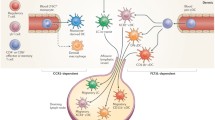Abstract
The human natural killer gene complex (NKC) encodes for numerous C-type lectin-like receptors (CTLR), which are expressed on various immune cells including natural killer (NK) cells and myeloid cells. Certain activation-induced, NKC-encoded CTLR are grouped into the C-type lectin domain family 2 (CLEC2 family) which, in humans, comprises AICL (CLEC2B), CD69 (CLEC2C), and LLT1 (CLEC2D). In this paper, we characterize a novel member of the CLEC2 family, the human orphan gene CLEC2A. The C-type lectin-like domain (CTLD) of CLEC2A is most similar to the CTLD of LLT1 (~60% similarity). Like mouse CLEC2 family members Clr-b and Clr-g, CLEC2A lacks two highly conserved cysteines (Cys4 and Cys5), which form an intramolecular bond in the CTLD of most CTLR. Alternative splicing of exon 2 and of two distinct terminal exons (exon 5A/B), respectively, gives rise to four CLEC2A variants differing in the usage of the transmembrane domain and/or in the carboxyterminal portion of the CTLD. CLEC2A transcripts were detected primarily in myeloid cell lines, but not in epithelial cell lines. In tissues, CLEC2A is selectively expressed in the skin and, at lower abundance, in hematopoietic and gonadal tissues. Finally, we show that the CLEC2A1 variant is readily expressed at the cell surface, where it may serve as a ligand for NKC-encoded NK receptors.







Similar content being viewed by others
References
Aldemir H, Prod'homme V, Dumaurier MJ, Retiere C, Poupon G, Cazareth J, Bihl F, Braud VM (2005) Cutting edge: lectin-like transcript 1 is a ligand for the CD161 receptor. J Immunol 175:7791–7795
Carlyle JR, Jamieson AM, Gasser S, Clingan CS, Arase H, Raulet DH (2004) Missing self-recognition of Ocil/Clr-b by inhibitory NKR-P1 natural killer cell receptors. Proc Natl Acad Sci USA 101:3527–3532
Clark HF, Gurney AL, Abaya E, Baker K, Baldwin D, Brush J, Chen J, Chow B, Chui C, Crowley C, Currell B, Deuel B, Dowd P, Eaton D, Foster J, Grimaldi C, Gu Q, Hass PE, Heldens S, Huang A, Kim HS, Klimowski L, Jin Y, Johnson S, Lee J, Lewis L, Liao D, Mark M, Robbie E, Sanchez C, Schoenfeld J, Seshagiri S, Simmons L, Singh J, Smith V, Stinson J, Vagts A, Vandlen R, Watanabe C, Wieand D, Woods K, Xie MH, Yansura D, Yi S, Yu G, Yuan J, Zhang M, Zhang Z, Goddard A, Wood WI, Godowski P, Gray A (2003) The secreted protein discovery initiative (SPDI), a large-scale effort to identify novel human secreted and transmembrane proteins: a bioinformatics assessment. Genome Res 13:2265–2270
Drickamer K (1988) Two distinct classes of carbohydrate-recognition domains in animal lectins. J Biol Chem 263:9557–9560
Hao L, Klein J, Nei M (2006) Heterogeneous but conserved natural killer receptor gene complexes in four major orders of mammals. Proc Natl Acad Sci USA 103:3192–3197
Iizuka K, Naidenko OV, Plougastel BF, Fremont DH, Yokoyama WM (2003) Genetically linked C-type lectin-related ligands for the NKRP1 family of natural killer cell receptors. Nat Immunol 4:801–807
Kelley J, Walter L, Trowsdale J (2005) Comparative genomics of natural killer cell receptor gene clusters. PLoS Genet 1:129–139
Lanier LL (2005) NK cell recognition. Annu Rev Immunol 23:225–274
Lanier LL, Chang C, Phillips JH (1994) Human NKR-P1A. A disulfide-linked homodimer of the C-type lectin superfamily expressed by a subset of NK and T lymphocytes. J Immunol 153:2417–2428
Llera AS, Viedma F, Sanchez-Madrid F, Tormo J (2001) Crystal structure of the C-type lectin-like domain from the human hematopoietic cell receptor CD69. J Biol Chem 276:7312–7319
Natarajan K, Sawicki MW, Margulies DH, Mariuzza RA (2000) Crystal structure of human CD69: a C-type lectin-like activation marker of hematopoietic cells. Biochemistry 39:14779–14786
Plougastel BF, Yokoyama WM (2006) Extending missing-self? Functional interactions between lectin-like NKrp1 receptors on NK cells with lectin-like ligands. Curr Top Microbiol Immunol 298:77–89
Rosen DB, Bettadapura J, Alsharifi M, Mathew PA, Warren HS, Lanier LL (2005) Cutting edge: lectin-like transcript-1 is a ligand for the inhibitory human NKR-P1A receptor. J Immunol 175:7796–7799
Roth P, Mittelbronn M, Wick W, Meyermann R, Tatagiba M, Weller M (2007) Malignant glioma cells counteract antitumor immune responses through expression of lectin-like transcript-1. Cancer Res 67:3540–3544
Sancho D, Gomez M, Sanchez-Madrid F (2005) CD69 is an immunoregulatory molecule induced following activation. Trends Immunol 26:136–140
Takahashi T, Dejbakhsh-Jones S, Strober S (2006) Expression of CD161 (NKR-P1A) defines subsets of human CD4 and CD8 T cells with different functional activities. J Immunol 176:211–216
Welte S, Kuttruff S, Waldhauer I, Steinle A (2006) Mutual activation of natural killer cells and monocytes mediated by NKp80-AICL interaction. Nat Immunol 7:1334–1342
Yokoyama WM, Plougastel BF (2003) Immune functions encoded by the natural killer gene complex. Nat Rev Immunol 3:304–316
Zelensky AN, Gready JE (2003) Comparative analysis of structural properties of the C-type-lectin-like domain (CTLD). Proteins 52:466–477
Zelensky AN, Gready JE (2005) The C-type lectin-like domain superfamily. FEBS J 272:6179–6217
Acknowledgement
Experiments comply with the current laws of the country in which the experiments were performed. This work was supported by grants from the Deutsche Forschungsgemeinschaft (SFB685/A1 to A.S. and GK794 to J.S.).
Author information
Authors and Affiliations
Corresponding author
Rights and permissions
About this article
Cite this article
Spreu, J., Kienle, E.C., Schrage, B. et al. CLEC2A: a novel, alternatively spliced and skin-associated member of the NKC-encoded AICL–CD69–LLT1 family. Immunogenetics 59, 903–912 (2007). https://doi.org/10.1007/s00251-007-0263-1
Received:
Accepted:
Published:
Issue Date:
DOI: https://doi.org/10.1007/s00251-007-0263-1




